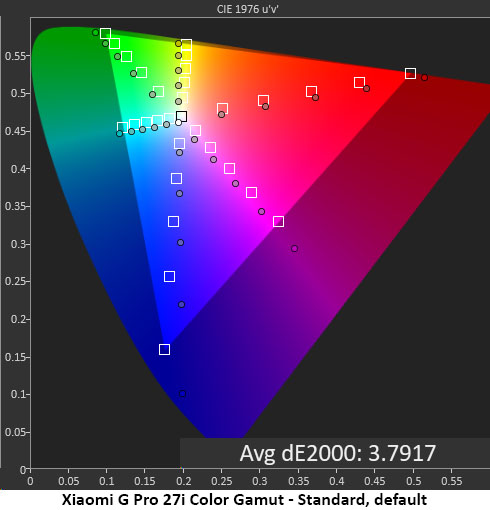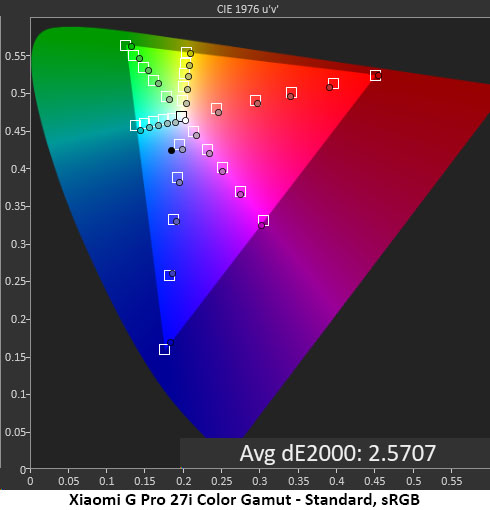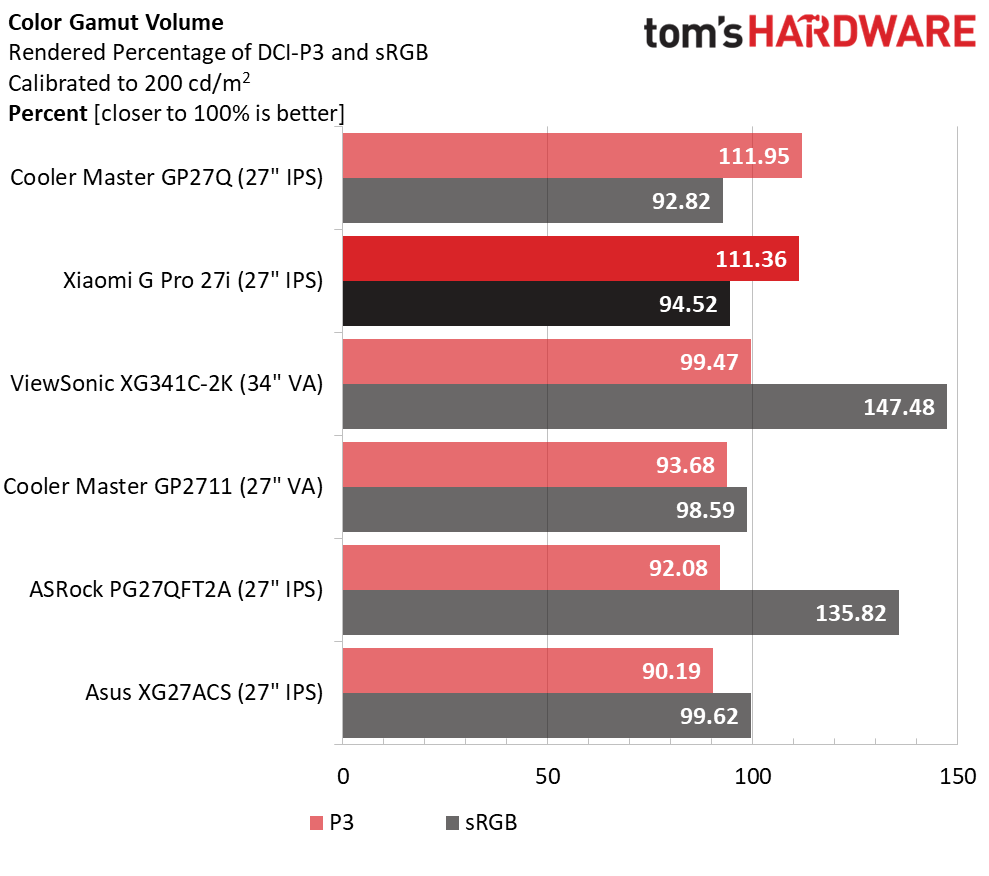Why you can trust Tom's Hardware
For the G Pro 27i tests, I changed the color space option to Native to have access to all calibration controls. If you set it to DCI-P3, Adobe RGB or sRGB, the color temp and gamma options are grayed out.
Grayscale and Gamma Tracking
Our grayscale and gamma tests use Calman calibration software from Portrait Displays. We describe our grayscale and gamma tests in detail here.




The G Pro 27i’s default grayscale tracking result is OK, but calibration is needed to remove a visible blue tint. You can see it in all steps from 40% onward. Gamma is the star here with visually perfect tracking to the 2.2 reference.
With adjustment to the RGB sliders, grayscale is now at reference level with no visible errors. Gamma is unchanged.
If you leave the color space option on DCI-P3, grayscale patterns are visibly purple in tone. This is definitely something that needs to be corrected. Gamma still tracks perfectly though.
The same behavior can be seen in the sRGB mode with a decidedly purple tint visible above 30% brightness. Gamma is mostly on the reference but takes a dip at 10-20%, meaning dark areas of the image are a bit grayer than they should be.
Comparisons




The G Pro 27i’s default grayscale error of 4.00dE is with color space set to Native. If you leave it on DCI-P3, it’s much higher at 5.13dE. For some users, this will be acceptable, and the good part is that color gamut tracking is very accurate. After trying the G Pro 27i out in different modes, I liked the calibrated Native mode with its 0.36dE grayscale error the best. It’s a tad over-saturated but the neutral grays and perfect gamma made the image pop with color and detail.
Get Tom's Hardware's best news and in-depth reviews, straight to your inbox.
Gamma tracking in every case is exemplary. The range of values is super low at just 0.05 from lowest to highest. And its actual average of 2.18 is just 0.91% off the 2.2 reference. This is excellent performance.
Color Gamut Accuracy
Our color gamut and volume testing use Portrait Displays’ Calman software. For details on our color gamut testing and volume calculations, click here.




The G Pro 27i has a huge color gamut enhanced by its Quantum Dot Film technology. When the color space option is set to Native, you can see that it exceeds the DCI-P3 limits in all colors, especially for blue and magenta. This isn’t strictly correct, but I had no complaint. The inner targets are reasonably close to the mark and track linearly so the picture looks naturally vivid.
Calibration tightens up the secondary hues, but blue and magenta are still over-saturated. If gamut accuracy is required for your application, the DCI-P3 and sRGB options are solid with all points on or close to their targets. Average error levels are below the visible threshold.
Comparisons


The G Pro 27i’s 2.44dE gamut error is measured in the Native color space. It’s mostly on target with some over-saturation in blue and magenta. Overall, though, it’s visually pleasing with a vibrant look.
In the gamut volume test, the G Pro 27i excels with over 111% coverage of DCI-P3. It’s pipped only by the GP27Q, and is well ahead of the other screens. That you get this much color for $390 is certainly impressive. The gamut specific modes, DCI-P3, Adobe RGB and sRGB, are all sufficiently accurate for color-critical work, but their grayscales are a little off the mark.
Test Takeaway: There is no way to calibrate the G Pro 27i and have every parameter on-spec. But the compromise still delivers a bright, saturated and colorful image that will satisfy nearly everyone. You can set more accurate gamut modes, but they have visible grayscale errors that might cause concern. For gaming though, you’ll want the Native color space in Standard mode with the calibration I specified above.
MORE: Best Gaming Monitors
MORE: How We Test PC Monitors
MORE: How to Buy a PC Monitor
MORE: How to Choose the Best HDR Monitor
Current page: Grayscale, Gamma and Color
Prev Page Brightness and Contrast Next Page HDR Performance
Christian Eberle is a Contributing Editor for Tom's Hardware US. He's a veteran reviewer of A/V equipment, specializing in monitors. Christian began his obsession with tech when he built his first PC in 1991, a 286 running DOS 3.0 at a blazing 12MHz. In 2006, he undertook training from the Imaging Science Foundation in video calibration and testing and thus started a passion for precise imaging that persists to this day. He is also a professional musician with a degree from the New England Conservatory as a classical bassoonist which he used to good effect as a performer with the West Point Army Band from 1987 to 2013. He enjoys watching movies and listening to high-end audio in his custom-built home theater and can be seen riding trails near his home on a race-ready ICE VTX recumbent trike. Christian enjoys the endless summer in Florida where he lives with his wife and Chihuahua and plays with orchestras around the state.
-
UnforcedERROR Reply
It's a monitor, so eARC is likely not a thing. That's 100% a TV-to-reciever/sound bar feature.Lucky_SLS said:Does the Monitor support HDMI pass through? Is it eARC? -
Lucky_SLS ReplyUnforcedERROR said:It's a monitor, so eARC is likely not a thing. That's 100% a TV-to-reciever/sound bar feature.
Hmm, here i was thinking it was an HDMI feature. -
UnforcedERROR Reply
HDMI was built for that reason, yes, but eARC specifically is complicated and requires a bunch of handshakes to work. It's really intended to simplify HT setups. HDMI does still pass audio on PC, but to my knowledge most monitors don't do eARC because they're not sending audio signals to other devices, unlike Smart TVs.Lucky_SLS said:Hmm, here i was thinking it was an HDMI feature. -
das_stig CON : No USB ports or internal speakersReply
Not for all, some people don't like to have cables cluttering up their monitor. I myself do like using a monitor for KBD & MSE with a single pass back to the computer, but don't miss internal speakers which are normally poor quality. -
markusveralius1980 Xiaomi's own FAQ states the monitor does not support VRR, but VRR seems to be working fine according to this review. Can someone clarify?Reply -
ammper Reply
On main page Xiomi - xiaomi-mini-led-gaming-monitor-g-pro-27i:markusveralius1980 said:Xiaomi's own FAQ states the monitor does not support VRR, but VRR seems to be working fine according to this review. Can someone clarify?
"FreeSync anti-tearing technology
The computer graphics card and monitor frame rate maintain real-time synchronisation to reduce tearing and lag in dynamic environments.
This ensures smoothness and stability during critical in-game moments." -
pepa3rd Hello, I can't find anywhere if the monitor is Flicker-Free (doesn't use PWM to control brightness).Reply -
MrSayear between these monitors may I ask what u would choose for video editing and media consumption and sometimes gaming because they are on a same price range in my countryReply
Samsung Odyssey G7 S28AG70
Cooler Master GP27Q
Xiaomi g pro 27i
Xiaomi Monitor is actually 60 dollars less than the other monitors and thats a lots of money in my country
If u could answer it would be a huge help
